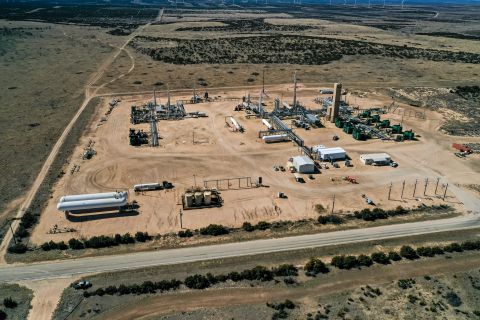The streak had to end at some point. During the week of April 2, ethane margins turned negative at both Conway and Mont Belvieu. Margins had been running at positive, albeit very slim, levels for the previous month.
The reason for this turn of events was that ethane prices held firm at Mont Belvieu and fell 13% at Conway as the market corrected the recent run-up in prices at the hub where demand remains low. Eventually, low prices will work to rebalance the market, encouraging both producer rejection and end-user usage of the storage overhang. At the same time, natural gas prices improved at both hubs after the U.S. Energy Information Administration (EIA) reported that natural gas inventory levels rose at a slower-than-expected rate.
For the week of April 2, ethane prices rose slightly to 30 cents per gallon (/gal), which is the average price they’ve traded at for the past month. The Conway price of 27 cents/gal was the lowest at the hub since it was 20 cents/gal the week of Feb. 5. Natural gas prices improved 2% to $4.40/MMBtu at Conway and 5% to $4.54/MMBtu at Mont Belvieu, as it appears that this injection season may struggle to fully reload storage levels.
The same is true of propane storage levels. LPG export levels this year are double what they were last year at the same time, which could have leave the market short come heating season. However, there is little concern that supplies will be fully tapped out, given that propane stayed in the U.S. this past winter as heating demand rose. LPG exports serve to provide producers with markets for their product when demand is down. When that demand is high, then exports decrease to meet domestic demand.
While propane prices increased at both hubs, with the Mont Belvieu price up 2% to $1.08/gal and the Conway price rising 5% to $1.09/gal, these prices aren’t high enough to limit LPG exports at this time. Although propane storage levels could be reloaded if end-users bid up prices, the same would hold true in the heating season and it appears that end-users and traders are willing to take their chances when they know these volumes are needed.
Crude oil prices rose to their highest level in a month. It is trading at $103 per barrel (/bbl), despite an increase in inventory levels, as gasoline demand remains high. While West Texas Intermediate (WTI) prices are increasing, Brent prices are failing to keep pace. This has narrowed the Brent-WTI spread to $4.38/bbl.
“The Brent-WTI spread should rebound by June as global refinery maintenance should be peaking and maintenance on North Sea fields takes place later this month,” according to En*Vantage’s Weekly Energy Report for April 10. “If the Brent-WTI spread remains below $5, it diminishes the economics of railing of Midcontinent crudes to the East Coast, suggesting that Cushing storage levels might increase or regional crude differentials in the U.S. will need to widen. Overall, we see no grave threat to WTI or Brent prices; short-term corrections can be expected, but WTI prices should remain above $95 during the summer.”.
Isobutane was the only heavy NGL that kept pace with the improvement in WTI prices as the Conway price rose 8% to $1.58/gal, its highest price since it was $1.61/gal the week of Feb. 5. The Mont Belvieu price of $1.29/gal was the hub’s highest price in a month. These increases are due to refinery turnarounds and greater gas processing levels.
Overall, the theoretical NGL bbl. price were largely unchanged. The Conway bbl. fell 1% to $43.29/bbl. with a 2% drop in margin to $27.21/bbl. The Mont Belvieu price rose 1% to $42.45/bbl. with a 2% decrease in margin to $25.86/bbl.
The most profitable NGL at both hubs remained C5+ at $1.78/gal at Conway and $1.72/gal at Mont Belvieu. This was followed, in order, by isobutane at $1.14/gal at Conway and 84 cents/gal at Mont Belvieu; butane at 74 cents/gal at Conway and 77 cents/gal at Mont Belvieu; propane at 68 cents/gal at Conway and 67 cents/gal at Mont Belvieu; and ethane at negative 2 cents/gal at Conway and negative 1 cent/gal at Mont Belvieu.
As mentioned, the EIA’s most recent gas storage levels reported a startling 4 billion cubic feet (Bcf) increase to 826 Bcf the week of April 4 from 822 Bcf the previous week. This was 51% below the 1.675 trillion cubic feet (Tcf) level reported last year at the same time and 55% below the 1.823 Tcf five-year average.
There should be a greater chance for storage build as there will be very limited cooling demand along the East Coast and in the Midwest, according to the National Weather Service’s forecast for the week of April 16.


Recommended Reading
Midstream M&A Adjusts After E&Ps’ Rampant Permian Consolidation
2024-10-18 - Scott Brown, CEO of the Midland Basin’s Canes Midstream, said he believes the Permian Basin still has plenty of runway for growth and development.
Post Oak-backed Quantent Closes Haynesville Deal in North Louisiana
2024-09-09 - Quantent Energy Partners’ initial Haynesville Shale acquisition comes as Post Oak Energy Capital closes an equity commitment for the E&P.
Analyst: Is Jerry Jones Making a Run to Take Comstock Private?
2024-09-20 - After buying more than 13.4 million Comstock shares in August, analysts wonder if Dallas Cowboys owner Jerry Jones might split the tackles and run downhill toward a go-private buyout of the Haynesville Shale gas producer.
Aethon, Murphy Refinance Debt as Fed Slashes Interest Rates
2024-09-20 - The E&Ps expect to issue new notes toward redeeming a combined $1.6 billion of existing debt, while the debt-pricing guide—the Fed funds rate—was cut on Sept. 18 from 5.5% to 5%.
Dividends Declared Sept.16 through Sept. 26
2024-09-27 - Here is a compilation of dividends declared from select upstream, midstream and service and supply companies.
Comments
Add new comment
This conversation is moderated according to Hart Energy community rules. Please read the rules before joining the discussion. If you’re experiencing any technical problems, please contact our customer care team.





